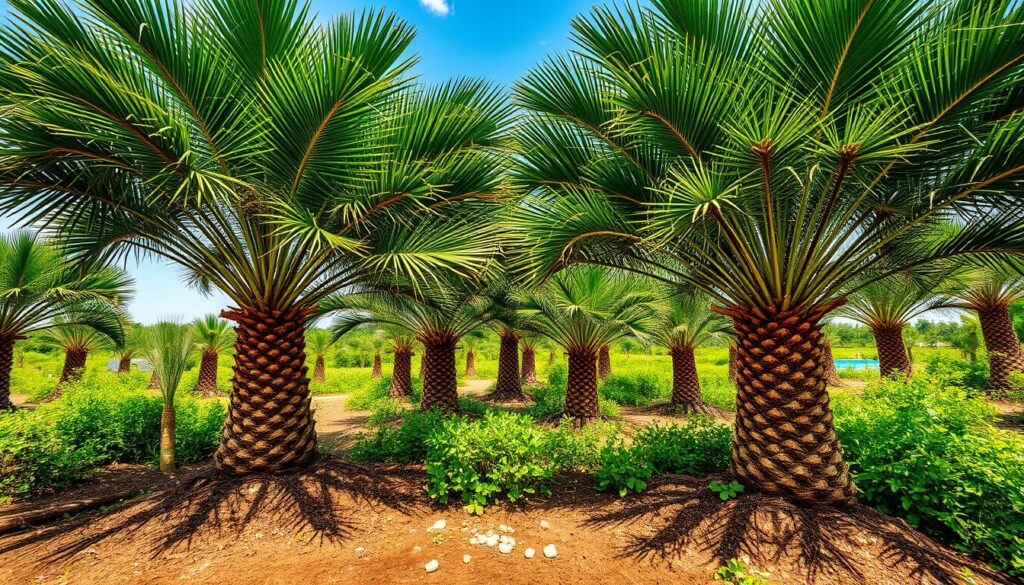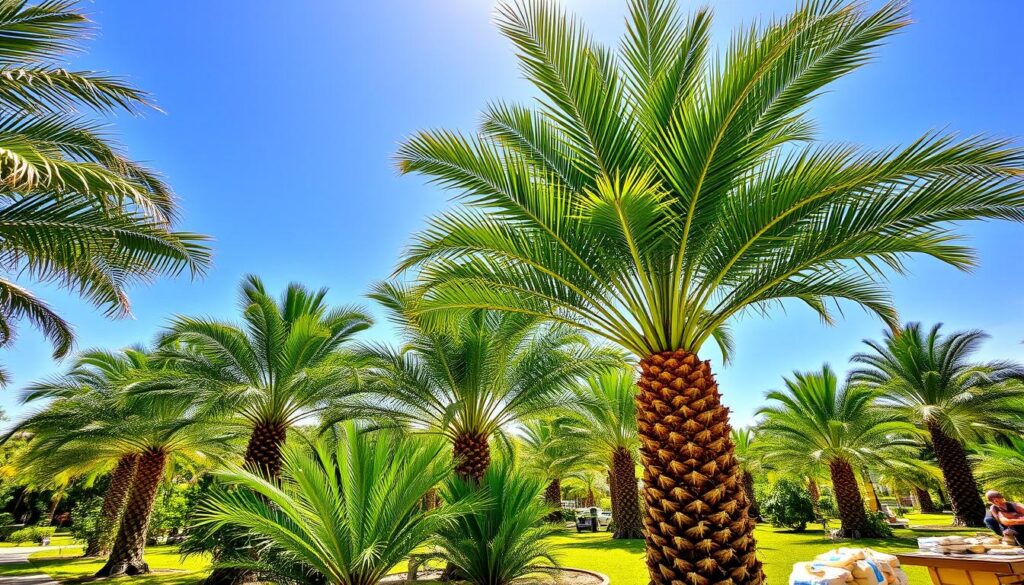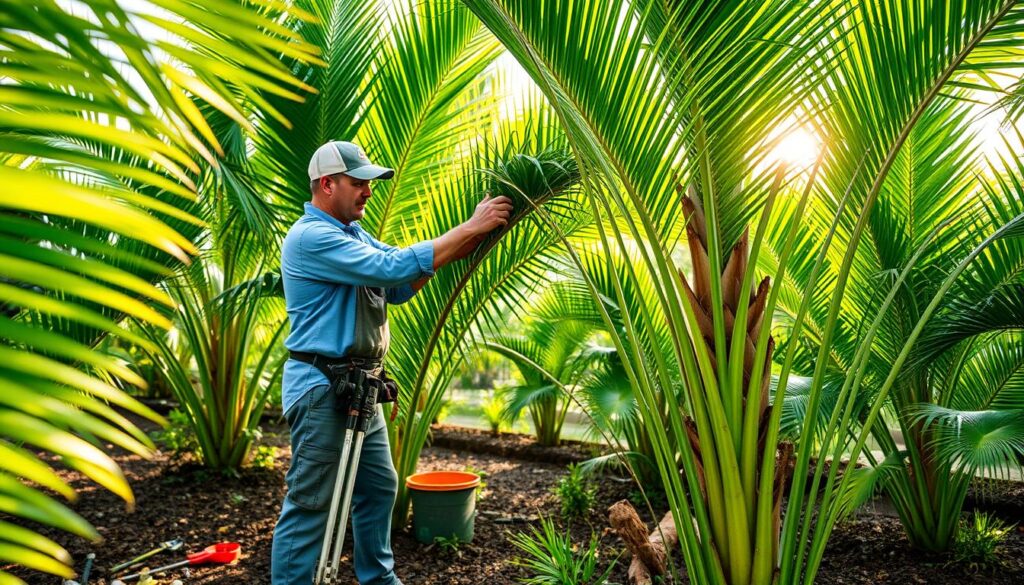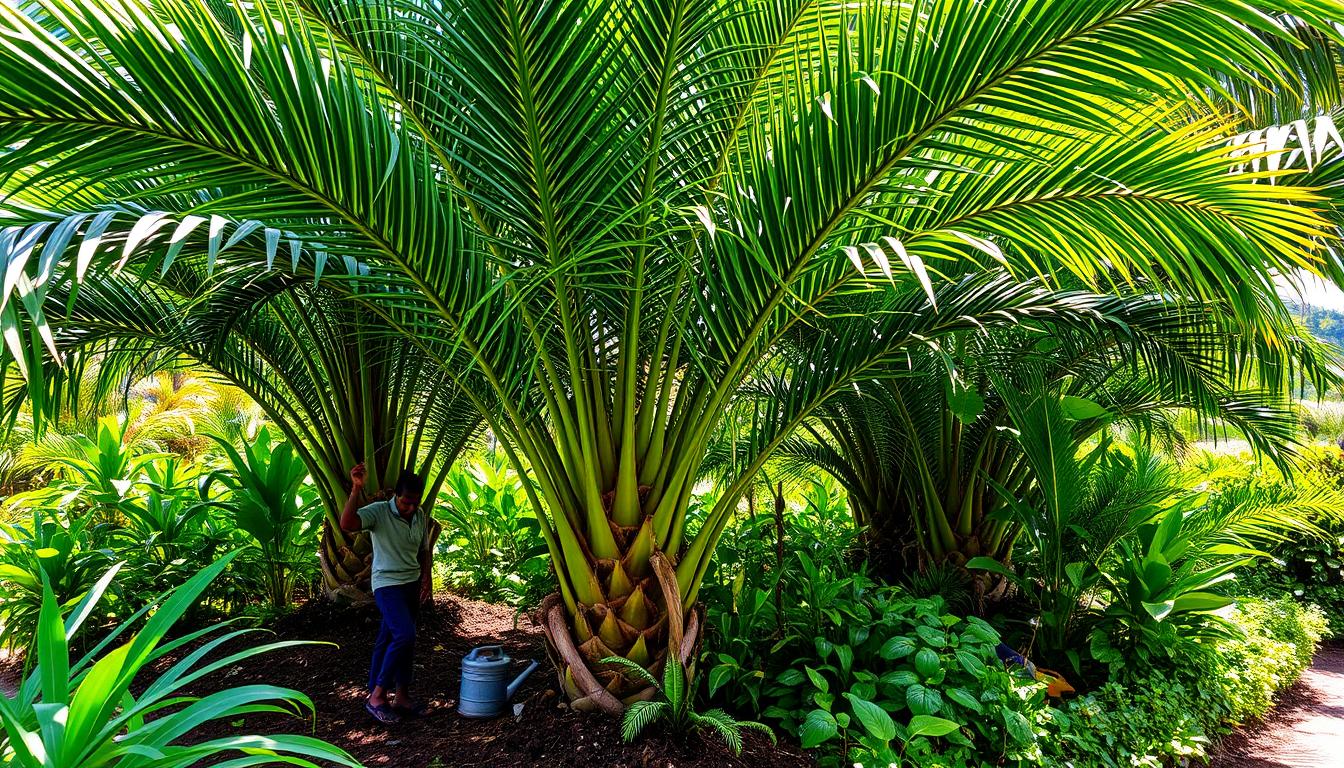There are about 2,600 palm species worldwide. This means there’s a wide range for indoor care. To keep your palm tree looking great and healthy, it needs the right light and soil. Proper palm tree care means knowing what your palm needs. This includes understanding indoor palm plant care and palm plant care.
Palm trees do best in bright, indirect light. They can also handle lower light, mostly in winter.
For indoor palm tree care, it’s important to balance watering and fertilizing. Too much water can cause root rot, while too little can make leaves turn brown. Use a loose, porous soil mix to help water drain well. Fertilizing during the growing season can help your palm stay healthy.
Table of Contents
Key Takeaways
- Choose the right palm tree for your space, considering factors like light and soil.
- Provide adequate light, with most palms preferring bright, indirect light.
- Use a loose, porous soil mix for efficient drainage and prevent overwatering.
- Fertilize during the active growing season, using organic fertilizers for sensitive palm varieties.
- Monitor your palm tree’s health, watching for signs of overwatering, such as yellow leaves, and underwatering, such as browning tips.
- Regular watering and fertilization promote the best growth and overall health of palm trees, making palm tree care and indoor palm plant care easier.
- Consider the specific needs of your palm, including palm plant care and indoor palm tree care, to ensure its beauty and health.
Understanding the Basics of Palm Tree Care
House plant palm tree care is all about the basics. Palms are easy to care for and can thrive in many conditions. But, they need specific care to stay healthy. Lighting is key, with most palms needing bright, indirect light.
Palms share similar growth needs and can grow well indoors. They’re great for busy people because they can handle neglect. To keep your palm happy, water and feed it right. Here are some tips:
Different Types of Palm Trees
There are many palm tree types, each with its own needs. Popular ones include the majesty palm, areca palm, and parlor palm. Choose based on light, temperature, and humidity in your home.
Basic Growth Requirements
Water palms deeply twice a week for the first few months. Later, water once or twice a week based on weather. Fertilize regularly with a slow-release fertilizer.
Climate Considerations
Palm trees like warm temperatures and high humidity. But they can adjust to different conditions. In cold climates, protect them from frost. Use burlap or frost cloth, or bring them indoors in winter.
Follow these tips to keep your palm tree happy. Provide the right light, water, and nutrients. Also, protect it from extreme temperatures and weather.
| Palm Tree Type | Lighting Requirements | Watering Requirements |
|---|---|---|
| Majesty Palm | Bright, indirect light | Deep watering twice a week |
| Areca Palm | Medium to bright light | Watering once a week |
| Parlor Palm | Low to medium light | Watering once every 10 days |
Essential Watering Guidelines for Healthy Palms
Watering is key in palm tree plant care. To grow palm plant well, knowing your palm’s water needs is vital. New palm trees need lots of water to grow strong roots.
To take care of palm trees right, water them often but don’t overdo it. Overwatering can harm the roots. Here are some tips to remember:
- Water your palm tree when the top 1-2 inches of soil feel dry to the touch.
- Use a slow-release fertilizer that contains essential nutrients like nitrogen, potassium, and magnesium.
- Soak the soil thoroughly during watering, but make sure not to leave standing water, which can cause root damage.
By following these tips and giving your palm tree the right water and nutrients, it will thrive. You’ll enjoy its beautiful leaves for many years.
| Palm Tree Type | Watering Frequency |
|---|---|
| Newly Planted | 3-4 times a week |
| Established | 1-2 times a week |
Optimal Lighting Conditions for Palm Trees
Understanding the right lighting for your indoor palm care is key. Different palms need different light levels. Some do well in low light, while others need lots of sun. Knowing your palm’s natural habitat helps choose the best light.
For instance, Parlor and Bamboo Palms do well in low light. They’re perfect for places with little natural light. But, Majesty and Sago Palms need more light and do great in sunny rooms.
Proper palm tree upkeep means balancing light with watering and fertilizing. The right light helps your palm grow strong and look great. Here are some tips for how to take care of a palm tree:
- Put low-light palms near a North-facing window or 3-6 ft. back from an East, West, or South-facing window.
- Place brighter light palms next to an obstructed South, West, or East-facing window or near a South, Southwest, or West-facing window with sheer curtains.
By knowing your palm’s light needs, you can create the best environment. This way, your palm will thrive, and you’ll enjoy the benefits of indoor palm care.
| Palm Species | Lighting Requirements |
|---|---|
| Parlor Palm | Low to medium light |
| Bamboo Palm | Low to medium light |
| Majesty Palm | Bright, indirect light |
| Sago Palm | Full, direct sun |
Soil and Fertilization Requirements
For the best palm tree care outdoor, knowing about soil and fertilization is key. Palms love well-draining soil and need a balanced diet to grow well. When caring for a palm plant, picking the right potting mix is important. Look for a mix that drains fast but holds moisture well, perfect for containers.
For palmetto tree care, use a plant food made just for palms. Fertilize four times a year, from March to October, based on where you live. Milorganite is recommended at 5 to 10 lbs every three months for palm trees.

Important tips for palm tree fertilization include:
* Use a fertilizer made for palms
* Don’t use turf fertilizers, as they can harm
* Follow the recommended application rate and frequency
* Keep fertilizer at least two feet from the palm tree trunk
| Palm Tree Height | Fertilizer Application Rate |
|---|---|
| 4 feet | 2 lbs |
| 10 feet | 5 lbs |
| 20 feet | 10 lbs |
Proper Palm Tree Pruning Techniques
Pruning is key for palm plant care outdoor. It keeps the tree healthy and looking good. When you’re how to take care of a palm tree plant, pruning is a must. It helps the tree grow well and avoids damage.
Removing dead, dying, or damaged fronds is important. Also, pruning fruit and flower stalks saves energy.
When to Remove Brown Fronds
Removing brown fronds stops disease and pests. But, only take out fronds that are really dead or dying. Cutting off healthy fronds can harm the tree.
A good guide is to remove fronds that are 50% or more brown.
Tools and Safety Measures
Using the right tools and being safe is vital when pruning palm trees. Wear gloves and goggles for protection. Use a ladder or cherry picker for high branches.
Also, clean your pruning tools after each use to avoid disease spread.
Here are some pruning tips for palm trees:
* Never cut off more than a year’s growth at once
* Only remove dead, dying, or damaged fronds
* Cut off fruit and flower stalks to save energy
* Clean your tools after each use
* Always wear gloves and goggles
| Palm Tree Type | Pruning Requirements |
|---|---|
| Self-cleaning palms | Naturally drop dead fronds, but may need pruning for safety |
| Non-self-cleaning palms | Need regular pruning to remove dead fronds and promote growth |
Common Palm Tree Problems and Solutions
Many people struggle with how to care for indoor palm tree plants. Issues like yellowing leaves, brown fronds, and pests are common. About 30% of palm owners face problems from wrong watering, causing yellow leaves and root issues. It’s key to understand palmmix plant care and meet your palms’ needs.
Some common problems and their solutions include:
- Leaf scorching and yellowing: show nutrient needs, solved with balanced fertilizer.
- Pest infestations: early action with beneficial insects like ladybugs helps.
- Root rot: avoid by not overwatering and ensuring good drainage.
Regular checks can spot these issues early, preventing big damage. Proper care, like deep but less frequent watering, and using clean tools, keeps palms healthy. Applying fungicides and insecticides also helps.

Remember, a well-cared-for palm tree adds beauty and elegance. So, it’s worth the effort to solve common problems.
| Problem | Solution |
|---|---|
| Yellowing leaves | Check watering schedule and fertilization |
| Brown fronds | Adjust humidity and temperature levels |
| Pest infestations | Introduce beneficial insects or use insecticides |
Indoor Palm Tree Care Specifics
To keep your water palm plant healthy, you need to know how to care for it indoors. Temperature control is key. Most indoor palms like temperatures between 65-75°F (18-24°C), perfect for indoor spaces.
Temperature Control
Keeping a steady temperature is important for palm tree upkeep. Don’t put your palm tree near heating vents, fireplaces, or drafty windows. This prevents sudden temperature changes that can harm the plant.
Humidity Management
Indoor palm trees love humid environments, between 40-60% relative humidity. Use a humidifier or mist the leaves often. This is key during the dry winter months.
Container Selection
Choosing the right container is also key. Pick a pot that drains well and is a bit bigger than the plant’s roots. This prevents waterlogged soil and root rot.
- Water your palm tree when the top inch of soil feels dry to the touch
- Fertilize your palm tree monthly during the growing season
- Prune your palm tree regularly to maintain its shape and promote healthy growth
Seasonal Palm Tree Maintenance
To keep your palm tree happy and thriving, it’s key to know how to take care of a palm in different seasons. Caring for palm trees means paying attention to their unique needs, which change with the seasons.
In winter, palm trees need less water and protection from harsh weather. But in summer, they need regular watering and fertilizing to grow well. By changing your palm tree maintenance routine with the seasons, you can keep your palm tree healthy and happy.

- Watering: reduce watering during winter months and increase during summer
- Fertilization: apply fertilizer during the growing season (spring-fall)
- Protection: protect your palm tree from extreme weather conditions, such as frost or intense heat
By following these tips and understanding your palm tree’s specific needs, you can give it the best care. This way, you’ll enjoy a thriving and beautiful palm tree all year round.
| Season | Watering | Fertilization |
|---|---|---|
| Winter | Reduce watering | No fertilization |
| Summer | Increase watering | Apply fertilizer |
Signs of Unhealthy Palm Trees
It’s important to know when palm trees are not doing well. They need regular care to stay healthy. This includes watching for signs of disease, nutrient problems, and pests.
Yellow leaves can mean the tree is not getting enough nutrients or is getting too much water. If leaves fall off too early, it might be because of stress or bad care. Slow growth could point to problems with the roots, soil, or not enough water and nutrients.
To fix these problems, you need to know how to care for your palms. This means watering them deeply but not too often, feeding them regularly, and trimming them to keep them healthy. Spotting and fixing these issues early can help your palm trees stay strong and healthy.
Identifying Disease Symptoms
- Leaf spots or lesions
- Wilting or curling fronds
- Unusual growths or holes
Keep an eye out for these signs and act quickly to fix any problems. This way, your palm trees will stay healthy and look great.
Creating a Thriving Environment for Your Palm Trees
Now you know how to care for your palm trees, indoors or outdoors. This guide has given you the tips you need. With the right care, your palm trees will stay lush and vibrant for years.
Palm trees come in many shapes, sizes, and colors. They can make your space look amazing. Whether you have a tall palm or a small one, you can use them to add beauty and shade to your area.
Keep an eye on your palm trees for any signs of trouble. Diseases, nutrient issues, or pests can harm them. By taking care of them, your palms will grow strong and become a beautiful part of your home.
Frequently Asked Questions
How do you keep a palm tree healthy?
Keeping a palm tree healthy starts with proper watering, sunlight, and soil care. Most palms love well-draining soil and need regular watering, but don’t let them sit in soggy conditions. A good rule of thumb is to keep the soil moist but not soaked. Palms also thrive with occasional fertilizing—use a balanced, slow-release fertilizer designed for palm trees. Lastly, make sure they get enough light. Some palms prefer full sun, while others do better in partial shade, so check the needs of your specific variety.
Should I cut off brown palm leaves?
Yes, but only when they’re completely brown and dry. If they’re still partly green, they might be helping the tree by providing nutrients. When trimming, be careful not to cut too close to the trunk—this can damage the tree and invite disease. Use clean, sharp pruning shears and avoid over-pruning, as palms rely on their fronds for energy.
What not to do with a palm tree?
Don’t overwater—soggy roots can lead to rot.
Don’t over-prune—removing too many fronds weakens the tree.
Don’t plant it too deep—burying the trunk can cause rot.
Don’t ignore pests—watch out for spider mites, scale, and other insects.
Don’t use regular lawn fertilizer—palms need special nutrients, like magnesium and potassium, to thrive.
How do you take care of a potted palm tree?
Potted palms need a bit more attention since they dry out faster. Use a well-draining potting mix and a container with drainage holes. Water when the top inch of soil feels dry, but avoid overwatering. Since potted palms don’t have access to natural soil nutrients, feed them with a palm-specific fertilizer every couple of months. Also, place them in a spot with bright, indirect sunlight and occasionally wipe the leaves to remove dust.
What does Epsom salt do for palm trees?
Epsom salt provides magnesium, which is essential for healthy palm growth. If your palm’s leaves are turning yellow with green veins, it might be lacking magnesium. Sprinkling a small amount of Epsom salt around the base of the tree (or mixing it with water and spraying the leaves) can help restore its vibrant color. However, don’t overdo it—too much salt can harm the soil.
What to do when a palm tree turns brown?
If your palm’s leaves are turning brown, figure out what’s causing it:
Underwatering? Give it more water but don’t flood the roots.
Overwatering? Improve drainage and let the soil dry out slightly between waterings.
Nutrient deficiency? Use a good palm fertilizer with magnesium and potassium.
Cold damage? Protect the tree from frost with a wrap or burlap.
Pests? Check for bugs like spider mites and treat with insecticidal soap if needed.
If only a few fronds are brown, trim them off once they’re fully dry. If the whole tree is brown, it might be in trouble—check the trunk and crown for signs of disease or rot.

